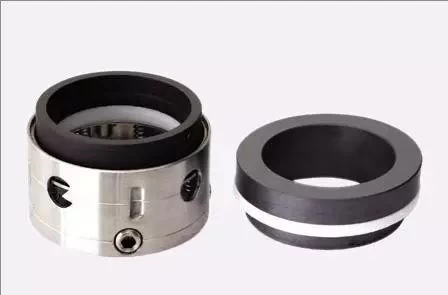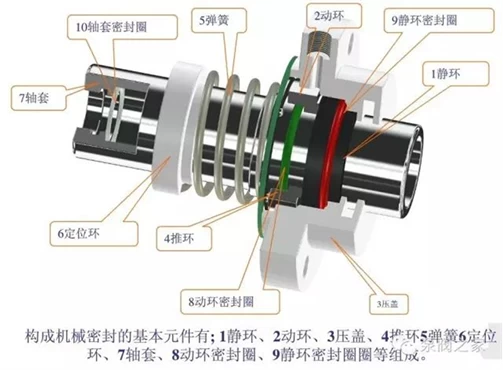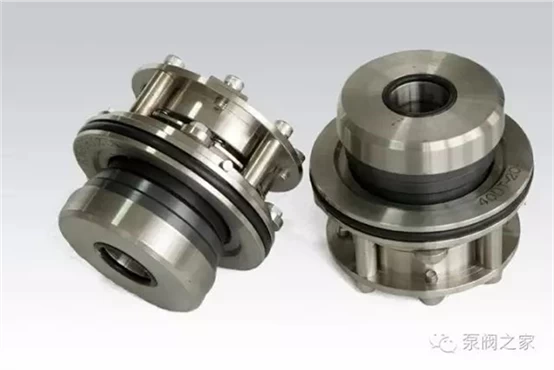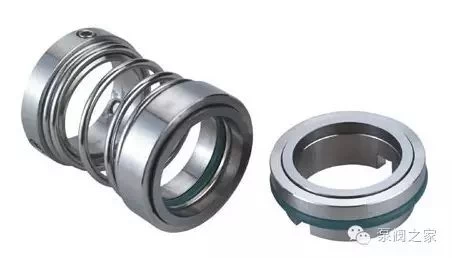Knowledge collection of mechanical seals - disassembly, assembly, selection,

Introduction to Mechanical Seals
Mechanical seals are one of the basic components of machinery
with precision and complex structures, and are key components of various pumps,
reaction synthesis kettles, turbo compressors, submersible motors and other
equipment. Its sealing performance and service life depend on many factors,
such as type selection, machine precision, correct installation and use, etc.
1. The basic concept of mechanical seal
Mechanical
seal refers to at least one pair of end faces
perpendicular to the axis of rotation under the action of fluid pressure and
the elastic force (or magnetic force) of the compensation mechanism and the
cooperation of the auxiliary seal to keep fit and relatively slide to prevent
Device for fluid leakage. The auxiliary seal of the compensation ring is a
metal bellows called a bellows mechanical seal.
2. The composition of the mechanical seal
mainly includes the following four types of
components. a. Main seals: moving ring and static ring. b. Auxiliary seal:
sealing ring. c. Compression parts: spring, push ring. d. Transmission parts:
skip seat and key or fixing screw.

should pay attention to the problem
1. Precautions during
installation
(1) Pay great attention to avoid installation deviation during installation
a. Tightening the gland should be carried out after the coupling is aligned. The bolts should be supported evenly to prevent the end face of the gland from deflecting. Check each point with a feeler gauge, and the error should not be greater than 0.05 mm.
b. Check the fit clearance (that is, concentricity) between the gland and the
outer diameter of the shaft or bushing. The surrounding area should be uniform.
Use a feeler gauge to check that the tolerance of each point is not greater
than 0.01mm.
(2) The compression of the spring should be carried out according to the
regulations, and the phenomenon of too large or too small is not allowed, and
the error is required to be 2.00mm. If it is too large, the specific pressure
of the end face will be increased, and the end face will be worn at a faster
rate. Too small will result in insufficient specific pressure and can not play
a sealing role.
(3) After the moving ring is installed, it is guaranteed to be able to move
flexibly on the shaft, and it should be able to spring back automatically after
pressing the moving ring to the spring.
2. Precautions when disassembling
(1) Be careful when disassembling the mechanical seal. It is strictly forbidden
to use hand hammers and flat shovels to avoid damage to the sealing components.
A pair of steel wire hooks can be used to extend into the gap of the drive seat
in the self-financing direction to pull out the sealing device. If the scale
cannot be disassembled, it should be cleaned before disassembly.
(2) If mechanical seals are used at both ends of the pump, they should take
care of each other during assembly and disassembly to prevent one from losing
the other.
(3) For the mechanical seal that has been in operation, if the gland is loose
and the seal moves, the dynamic and static ring parts must be replaced, and it
should not be re-tightened to continue to use. Because after such a movement,
the original running track of the friction pair will change, and the sealing of
the contact surface will be easily damaged.

Proper Operation and Maintenance of Mechanical Seals
1.
Preparations and precautions before start-up
(1) Comprehensively check whether the mechanical seal, as well as the
installation of auxiliary devices and pipelines are complete, and whether they
meet the technical requirements.
(2) Conduct a static pressure test before starting the mechanical seal to check
whether there is any leakage of the mechanical seal. If there is a lot of
leakage, find out the cause and try to eliminate it. If it is still invalid, it
should be disassembled for inspection and reinstalled. Generally, the static
pressure test pressure is 2~3 kg/cm2.
(3) Press the pump steering wheel to check whether it is brisk and even. If the
cranking is difficult or does not move, you should check whether the assembly
size is wrong and whether the installation is reasonable.
2. Installation and outage
(1) Keep the sealed cavity filled with liquid before starting. When
transporting solidified medium, steam should be used to heat the sealed cavity
to melt the medium. The car must be cranked before starting to prevent the soft
ring from breaking due to sudden start.
(2) For mechanical seals that use the external oil sealing system of the pump,
the oil sealing system should be started first. Stop the oil sealing system
last after parking.
(3) After the hot oil pump is out of service, the cooling water in the oil seal
cavity and the end face seal cannot be stopped immediately. The cooling water
should be stopped only when the oil temperature at the end face seal drops
below 80 degrees, so as not to damage the sealing parts.
3. Operation
(1) If there is a slight leakage after the pump is started, it should be observed for a period of time. If the leakage does not decrease after 4 hours of continuous operation, the pump should be stopped for inspection.
(2) The operating pressure of the pump should be stable, and the pressure
fluctuation should not exceed 1 kg/cm2.
(3) When the pump is in operation, avoid pumping out to avoid dry friction on
the sealing surface and damage to the seal.
(4) The sealing condition should be checked frequently. During operation, when
the leakage exceeds the standard, the heavy oil is not more than 5 drops/min,
and the light oil is not more than 10/min. If there is no improvement within
2-3 days, stop the pump and check the sealing device.
"Sealing" has a long history of development in our country. The
ancients used cotton, hemp and other fibers to make seals for water-lifting
machinery, while foreign countries did not use packing until 1782. The
importance of sealing is not mentioned here. There is a discipline called
"Sealing Science" that studies the laws of sealing, sealing device
design technology and applied scientific principles. Research institutions also
have professional courses dedicated to the study of sealing science. In our
country, so far, as far as I know, there are fluid Mechanics and hydraulic
transmission and other courses, but there is no "seal system" that
specializes in sealing, so our research level is still far behind that of
foreign countries
. There are many professional fields for
seal design, except for materials and machinery. On the other hand, there are
also mechanics (including fluid mechanics, boundary layer theory, etc.),
tribology, automatic control, etc. Therefore,
for sealing, the research difficulty is relatively large. The level of the
domestic sealing industry is comparable to that of foreign countries. The gap
should be no less than 50 years.
About the sealing principle
If
you want to learn sealing, you must first understand leakage. If you understand
the principle of leakage, you will have the corresponding sealing mechanism.
There are three types of leakage—
one is through leakage, which is the leakage between the gaps of the sealing
surfaces.
The second is leakage, which is the leakage of the sealed fluid through the capillary of the seal material
The third is diffusion, which refers to the material transfer of the sealing medium through the gap or the capillary of the material under the action of the concentration difference.

About the sealing method
There are roughly several sealing methods——
1. Minimize the sealing parts as far as possible
2. Blockage and isolation
3. Lead out or inject
4. Increase leakage resistance
5. Add active components in the channel
6. Combination of various sealing methods

Common Sealing Forms
Gasket seals, packing seals, mechanical seals, non-contact seals, and injection pressure plugging are common sealing forms. Among them, the packing seal should be considered the most common, and it also includes soft packing seal, hard packing seal and formed packing seal. Formed packing seals include our common O-rings, Y-rings, oil seals and more. Non-contact seals include gap seals, labyrinth seals, floating seals, dynamic seals, magnetic fluid seals and hermetic seals.

Common gasket properties and new materials and technologies
1.
Commonly used gasket performance
When using the valve, the original gasket is often replaced according to the
specific situation. Common gaskets are: rubber flat gasket, rubber O-ring,
plastic flat gasket, PTFE bag gasket, asbestos rubber gasket, metal flat
gasket, metal special-shaped gasket, metal foreskin gasket, wave gasket, wound gasket,
etc.
(1) Rubber flat gasket: easy
to deform, easy to press, but poor pressure and temperature resistance, only
used in places with low pressure and low temperature. Natural rubber has
certain acid and alkali resistance, and the operating temperature should not
exceed 60°C; neoprene rubber can also withstand
certain acids and alkalis, and the operating temperature is 80°C; nitrile rubber is oil-resistant and can be used up to 80°C; The temperature performance is also stronger than ordinary
rubber, and it can be used in 150°C medium.
(2) Rubber O-shaped gasket: The section shape is a perfect circle, and it has a certain
self-tightening effect. The sealing effect is better than that of the flat
gasket, and the pressing force is smaller.
(3) Plastic flat gasket: The
biggest feature of plastic is its good corrosion resistance, and most plastics
have poor temperature resistance. PTFE is the crown of plastics. It not only
has excellent corrosion resistance, but also has a relatively wide temperature
range. It can be used for a long time within -180℃~+200℃.
(4) PTFE-wrapped gasket: In order to give full play to the advantages of PTFE and make up for its
shortcomings of poor elasticity , it is made of PTFE-wrapped rubber or asbestos
rubber gasket. In this way, it not only has the same corrosion resistance as
the PTFE flat washer, but also has good elasticity, which enhances the sealing
effect and reduces the pressing force. Its cross-sectional shape is shown in
Figure 4-20.
(5) Asbestos rubber gasket: cut
from asbestos rubber sheet. Its components are 60-80% asbestos and 10-20%
rubber, as well as fillers and vulcanizing agents. It has good heat resistance,
cold resistance, and chemical stability, and it is abundant in supply and cheap
in price. When in use, the pressing force does not need to be very large.
Because it can adhere to metal, it is best to coat the surface with a layer of
graphite powder to avoid laborious removal.
There are four colors of asbestos rubber sheet: gray, used for low pressure
(brand XB-200, pressure resistance ≤ 16 kg/cm2, temperature
resistance 200 ℃); red, used for medium pressure (brand
XB-350, pressure resistance up to 40kg/cm2, temperature resistance 350℃); purple, used for high pressure (grade XB-450, pressure resistance
100kg/cm2 temperature resistance 450℃); green, used for
oil, pressure resistance is also very good .
(6) Metal flat heating ring: lead, temperature resistance 100°C; aluminum 430°C; copper 315°C; low carbon steel 550°C; silver 650°C; nickel 810°C; Monel (nickel-copper) alloy 810°C,
stainless steel 870°C . Among them, lead has poor
pressure resistance, aluminum can withstand 64 kg/cm2, and other materials can
withstand high pressure.
(7) Metal anisotropic washers:
Lens gasket: It has self-tightening effect and is used for high-pressure valves. Such as pressure seal gate valve.
Oval washer: also belongs to high pressure self-tightening washer.
Double tapered gasket: used for high-pressure internal self-tightening seal.
In addition, there are square, rhombus, triangle, tooth shape, dovetail shape,
B shape, C shape, etc., which are generally only used in high and medium
pressure valves.
(8) Metal sheath gasket: Metal
has good temperature and pressure resistance and good elasticity. Foreskin
materials include aluminum, copper, low carbon steel, stainless steel, Monel
alloy, etc. The filling materials inside include asbestos,
polytetrafluoroethylene, glass fiber, etc.
(9) Wave washer: It has the
characteristics of small compression force and good sealing effect. It is often
used in the form of a combination of metal and non-metal.
(10) Wound gasket: It is
a thin metal strip and a non-metal strip that are tightly bonded together and
wound into a multi-layer circular shape. The section is wavy and has good
elasticity and sealing. The metal belt can be made of 08 steel, 0Cr13, 1Cr13,
2Cr13, 1Cr18Ni9Ti, copper, aluminum, titanium, Monel alloy, etc. Non-metal
strip materials include asbestos, polytetrafluoroethylene, etc.
Above, when describing the performance of the gasket, some figures are listed.
It must be noted that these numbers are closely related to the flange form,
medium conditions, and installation and repair techniques. Sometimes they can
be exceeded, and sometimes they cannot be reached. Moreover, the pressure and
temperature resistance properties are also mutually transformed. For example,
the higher the temperature, the higher the resistance. The pressure ability is
often reduced, and these subtle problems can only be realized in practice.

2. New materials and new technologies
The sealing gaskets described above are not comprehensive, and the sealing technology is developing rapidly. The following examples introduce several new materials and new technologies.
(1) Liquid sealing: With
the rapid development of the polymer organic synthesis industry, liquid
sealants have appeared for static sealing; this new technology is usually
called liquid sealing. The principle of liquid sealing is to use the adhesion,
fluidity and monomolecular film effect of liquid sealant (the thinner the film,
the greater the natural recovery tendency), and make it work like a gasket
under appropriate pressure. Therefore, the sealant used is also called liquid
gasket.
(2) PTFE raw material seal: PTFE
is also a high molecular organic compound. Before it is sintered into a
product, it is called raw material. It is soft in texture and has a
monomolecular film effect. The tape made of raw material is called raw material
tape, which can be rolled into a disk for long-term storage. It can be formed
freely during use, and any joint, as long as there is pressure, will form a
ring-shaped membrane that evenly acts as a seal. As the gasket between the
valve body and the valve cover in the valve, it can be pried open a gap and
stuffed into the raw material belt without taking out the disc or gate. The
pressing force is small, not sticky to hands, not sticky to the flange surface,
and it is very convenient to replace. Best suited for tongue and groove
flanges. PTFE raw materials can also be made into tubes and rods for sealing.
(3) Metal hollow O-ring: good
elasticity, small pressing force, and self-tightening effect. Various metal
materials can be used, so that it can adapt to low temperature, high
temperature and strong corrosive media.
(4) Graphite plate sealing ring: In
people's impression, graphite is a brittle substance that lacks elasticity and
toughness, but the specially treated graphite is soft in texture and good in
elasticity. In this way, the heat resistance and chemical stability of graphite
can be displayed in the gasket material; moreover, the gasket has a small
compression force and excellent sealing effect. This graphite can also be made
into a belt, which can be combined with a metal belt to form a wound gasket
with excellent performance. The emergence of graphite plate sealing rings and
graphite----metal wound gaskets is a major breakthrough in high-temperature
corrosion-resistant sealing. This type of gasket has been produced and used in
large quantities abroad.
 +86 512 68781993
+86 512 68781993 


















